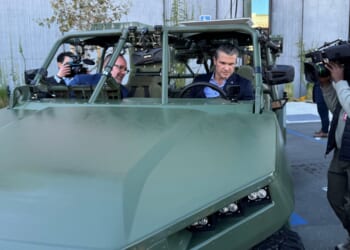The Royal Navy conducts constant monitoring operations of foreign vessels near its shores—particularly when those vessels belong to Russia.
The Royal Navy has routinely tracked the movements of Russian warships transiting the English Channel between Britain and Francee—but this week, the challenge has been a bit different.
The Portsmouth-based Type 45 Daring-class destroyer HMS Duncan shadowed the Russian Navy Udaloy-class destroyer Vice-Admiral Kulakov for more than two full days, making it notable as the first time the British warship operated under direct NATO command.
Interestingly, both the British and Russian destroyers are named for “hero” admirals of their respective nations.
Duncan Shadowing Udaloy
HMS Duncan, the Royal Navy destroyer, is currently attached to Standing NATO Maritime Group 1 (SNMG1), which serves as the international military alliance’s main task force in the northern European waters.
The warship is the seventh Royal Navy vessel named for Admiral Adam Duncan, 1st Viscount Duncan and hero of the Battle of Camperdown during the French Revolutionary Wars. It was activated by NATO Allied Maritime Command to shadow the Russian vessel. A Wildcat helicopter from 815 Naval Air Squadron, launched by HMS Duncan, was supported by a Dutch Air Force NH90 to further aid in monitoring the Russian warship, with additional support from the French Navy.
The Royal Navy conducts constant monitoring operations of foreign vessels near its shores—particularly when those vessels belong to Russia, with whom relations are exceptionally hostile due to the latter’s invasion of Ukraine in 2022.
“This operation highlights the Royal Navy’s commitment to safeguarding UK waters and working seamlessly with our NATO allies to ensure the security of our shared maritime spaces,” said Commander Dan Lee, commanding officer (CO) of HMS Duncan. “The professionalism and teamwork displayed by all involved ensured the operation was conducted safely and effectively, showcasing our shared resolve to uphold international maritime norms.”
The Daring-class destroyer first intercepted the Vice-Admiral Kulakov, named for Soviet Navy officer Nikolai Mikhailovich Kulakov, in the North Sea. In the following days, it monitored the Russian warship as it passed westward. The ultimate destination of the Udaloy-class destroyer is unknown, but NATO and the Royal Navy will continue to monitor its movements.
“The Royal Navy stands ready to respond to any Russian naval activity. They conduct constant monitoring operations to safeguard Britain and our territorial waters,” said British Armed Forces Minister Al Carns in a statement to the media. “Once again, the Royal Navy has deployed under Allied Maritime Command, underpinning our unwavering solidarity with NATO to counter Russian activity.”
Last week, British and French warships also tracked the movement of the Russian Project 636.3 (NATO reporting name “Improved Kilo II-class”) submarine B-261 Novorossiysk through the English Channel. There had been speculation that the diesel-electric powered boat, which had surfaced and was being escorted by a tug, had suffered a mishap at sea and was limping home to St. Petersburg, but the Kremlin said it was a routine transit.
Another British warship, the Type 23 frigate HMS Somerset, is now deployed under NATO command, patrolling the “sea lanes between Iceland, the Faroe Islands and Scotland—the critical passage between the North Atlantic and Arctic waters,” Forces News reported.
Destroyer Versus Destroyer: A Head-to-Head Comparison
| Vessel | Type 45 Destroyer (UK) | Udaloy-Class Destroyer (Russia) |
| Year Introduced | 2009 | 1980 |
| Number Built | 6 | 13 (8 in service) |
| Length | 152.4 m (500 ft) | 163 m (535 ft) |
| Beam (Width) | 21.2 m (69 ft 7 in) | 19.3 m (63 ft) |
| Displacement | 7,500 tonnes | 7,570 tonnes (fully loaded) |
| Powerplant | Two Rolls-Royce WR-21 gas turbine engines | COGAG (combined gas and gas) system with four gas turbines |
| Top Speed | 32 knots (36.8 mph, 59.2 km/h) | 35 knots (40.3 mph, 64.8 km/h) |
| Range | 7,000 nmi (8,055 mi, 12,964 km) | 10,500 nmi (12,083 mi, 19,446 km) |
| Loadout | “Sea Viper” Principal Anti-Air missile system (PAAMS); 48-cell Sylver A50 VLS; Aster 15 and Aster 30 short-range missiles; two Mk. 141 quad missile launchers; one BAE Mark 8 Mod.1 gun; two DS30B Mark 1 30mm machine guns; two M134 miniguns; two Mk 15 Phalanx CIWS | Eight SS-N-14 Silex anti-ship missiles; 64-cell SA-N-9 Gauntlet VLS; two 100mm dual-purpose naval guns; four 30mm AK-630 CIWS; two 21-inch torpedo tubes; two RBU-6000 rocket launchers |
| Crew | 191 | ~300 |
Both the Royal Navy and Russian Navy destroyers should be seen as highly capable vessels.
As Christian D. Orr wrote for The National Interest in February, “From combating pirates and defending air attacks, to delivering humanitarian aid, these high-tech Type 45 destroyers are the pride of the naval fleet.”
All six of the United Kingdom’s Daring-class destroyers have received, or will receive, significant upgrades, notably the Power Improvement Project (PIP), which was intended to address several issues with their WR-21 gas turbine engines, which proved unreliable in warm climates.
HMS Dauntless and HMS Dragon have already received the PIP modification, and the former vessel has returned to service, with HMS Dragon expected to have its refit completed later this year. Work continues on HMS Daring.
HMS Defender, HMS Diamond, and HMS Duncan are next scheduled to receive the upgrades. Current plans call for updates to all Type 45 destroyers to be completed by 2028.
About the Author: Peter Suciu
Peter Suciu has contributed over 3,200 published pieces to more than four dozen magazines and websites over a 30-year career in journalism. He regularly writes about military hardware, firearms history, cybersecurity, politics, and international affairs. Peter is also a contributing writer for Forbes and Clearance Jobs. He is based in Michigan. You can follow him on Twitter: @PeterSuciu. You can email the author: [email protected].
Image: Shutterstock / Kevin Shipp.
















